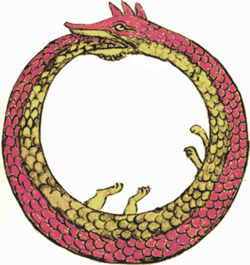From Wikipedia, the free encyclopedia

The Green-beard effect is a form of sexual selection in which individuals with alleles that create unique observable traits tend to select people with similar trait. In this diagram note that the individuals with the trait for the same color head mate with each other and create offspring while those with different color heads do not mate.
The green-beard effect is a hypothesis used in evolutionary biology to explain selective altruism between designated individuals of a species. It is based on the gene-centered view of evolution, which emphasizes an interpretation of natural selection from the point of view of the gene which acts as an agent that has the metaphorical "goal" of maximizing its own propagation. A gene for (behavioral) selective altruism can be favored by (natural) selection if the altruism is primarily directed at other individuals who share the same allele.
A green-beard effect occurs when an allele, or a set of linked alleles, produce three phenotypic effects:
- a perceptible trait, — the hypothetical "green beard"
- recognition of this trait in others; and
- preferential treatment to those recognized.
This can have the effect of delineating a subset of organisms within a population that is characterized by members who show greater cooperation toward each other, this forming a "clique" that can be advantageous to it's members who are not necessarily kin.
Green-beard effect could increase altruism on green-beard phenotypes and therefore its presence in a population even if alleles are assisting other genes that are not exact copies of themselves in a molecular sense; all that is required is that they produce the three phenotypic characteristics described above. Green-beard alleles are vulnerable to mutant genes arising that produce the perceptible trait without the helping behaviour.
The idea of a green-beard allele was proposed by William D. Hamilton in his articles of 1964,[1][2] and named as "Green Beard" by Richard Dawkins in The Selfish Gene (1976).[3][4]
Examples
In the last several years, evolutionary biologists have questioned the potential validity of green-beard alleles, suggesting it would be extraordinarily rare for a single allele to produce three complex phenotypic effects. This criticism has led some to believe that they simply cannot exist or that they only can be present in less complex organisms, such as microorganisms. Several discoveries within the past ten years have illuminated the validity of this critique.The concept remained a merely theoretical possibility under Dawkins' selfish gene model until 1998, when a green-beard allele was first found in nature, in the red imported fire ant (Solenopsis invicta).[4][5] Polygyne colony queens are heterozygous (Bb) at the Gp-9 gene locus. Their worker offspring can have both heterozygous (Bb) and homozygous (BB) genotypes. The investigators discovered that homozygous dominant (BB) queens, which in the wild form produce monogyne rather than polygyne colonies, are specifically killed when introduced into polygyne colonies, most often by heterozygous (Bb) and not homozygous (BB) workers. They concluded that the allele Gp-9b is linked to a greenbeard allele which induces workers bearing this allele to kill all queens that do not have it. A final conclusion notes that the workers are able to distinguish BB queens from Bb queens based on an odor cue.
The gene csA in the slime mould Dictyostelium discoideum, discovered in 2003,[6] codes for a cell adhesion protein which binds to gp80 proteins on other cells, allowing multicellular fruiting body formation on soil. Mixtures of csA knockout cells with wild-type cells yield spores, "born" from the fruiting bodies, which are 82% wild-type (WT). This is because the wild-type cells are better at adhering and more effectively combine into aggregates; knockout (KO) cells are left behind. On more adhesive but less natural substances, KO cells can adhere; WT cells, still better at adhering, sort preferentially into the stalk.
In 2006, green beard-like recognition was seen in the cooperative behavior among color morphs in side-blotched lizards, although the traits appear to be encoded by multiple loci across the genome.[7]
A more recent example, found in 2008, is a gene that makes brewer's yeast clump together in response to a toxin such as alcohol.[8] By investigating flocculation, a type of self-adherence generally present in asexual aggregations, Smukalla et al.[9] showed that S. cerevisiae is a model for cooperative behavior evolution. When this yeast expresses FLO1 in the laboratory, flocculation is restored. Flocculation is apparently protective for the FLO1+ cells, which are shielded from certain stresses (ethanol, for example). In addition FLO1+ cells preferentially adhere to each other. The authors therefore conclude that flocculation is driven by this greenbeard allele.
A mammalian example appears to be the reproductive strategy of the wood mouse, which shows cooperation among spermatozoa. Single sperms hook in each other to form sperm-trains, which are able to move faster together than single sperm would do.[10]
